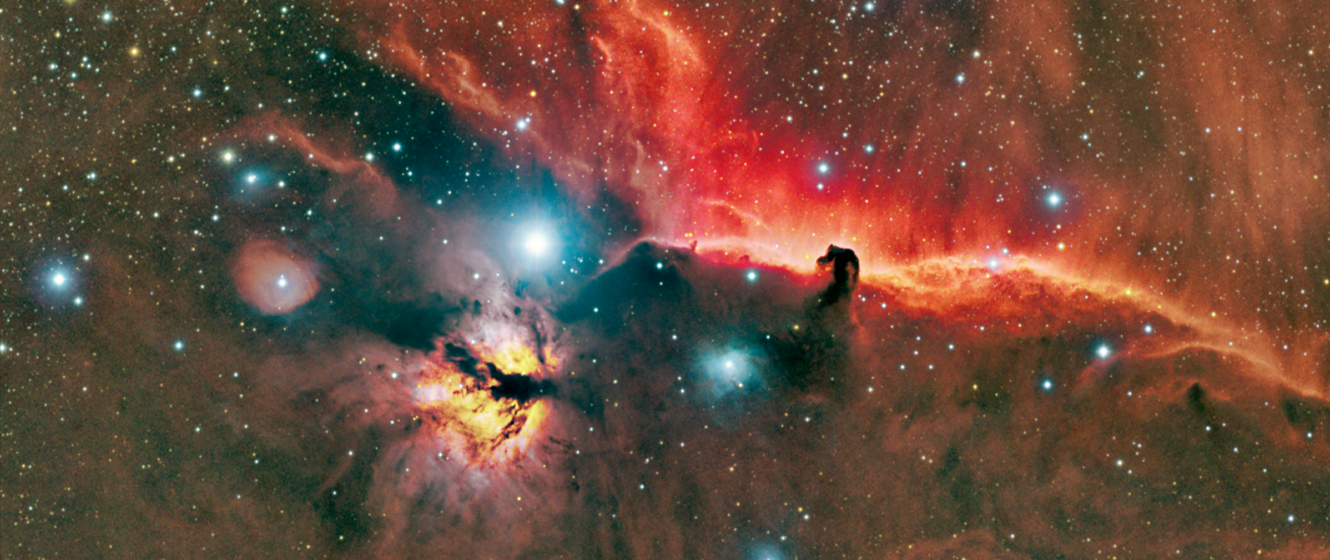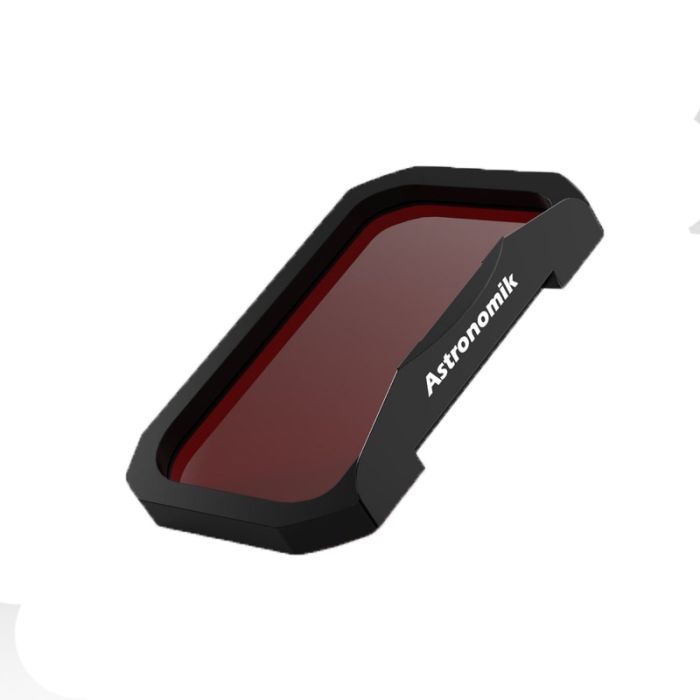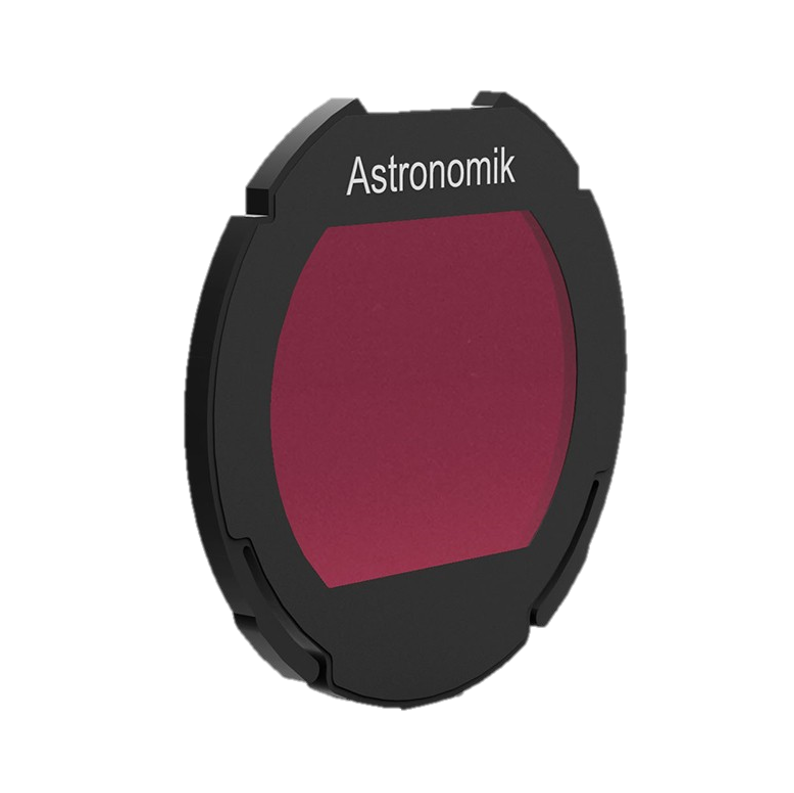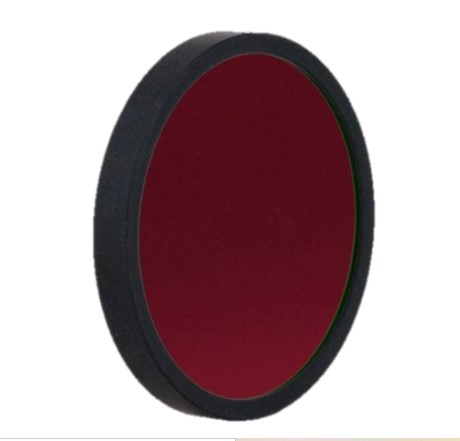
Astronomik H Alpha CCD filters are a popular choice for exact capture of the lightest whispers of hydrogen-alpha emission in nebulae. The H-alpha line at 656 nm can be isolated by these filters, which have a narrow bandwidth of 6 or 12 nm. This enables imagers to uncover complex structures within luminous gas clouds, even in environments with light pollution. The new Optolong L-eXtreme F2 Filter is here for individuals who want even better outcomes with quick optical systems. Intended for high-magnification telescopes, it catches H-alpha and OIII emissions in a very balanced manner.
Highlighted Products
Astronomik H-Alpha 12 nm EOS Clip Filter
The Astronomik H-Alpha 12 nm EOS Clip Filter is designed for astrophotography with Canon EOS cameras. It isolates the H-alpha wavelength at 656 nm, enhancing contrast for nebula imaging by blocking unwanted light pollution. Its clip-in design ensures easy installation, making it ideal for capturing detailed deep-sky objects.
Astronomik H-Alpha 12 nm CCD Sony Alpha 7 Clip Filter
The Astronomik H-Alpha 12 nm CCD Sony Alpha 7 Clip Filter enhances astrophotography by isolating the H-alpha wavelength at 656 nm. Designed specifically for Sony Alpha 7 cameras, it improves contrast in nebulae imaging by reducing light pollution. Its clip-in design ensures quick installation and high-quality deep-sky image capture.
Astronomik H-Alpha 6 nm CCD Filter - 36 mm Round3
The Astronomik H-Alpha 6 nm CCD Filter in 36 mm round format is optimized for astrophotography. It isolates the H-alpha wavelength at 656 nm, enhancing contrast and detail in nebulae by filtering out unwanted light pollution. Ideal for deep-sky imaging, it delivers high-quality, detailed results in long-exposure photography.
Astronomik MaxFR H-alpha 6 nm CCD 1.25" (M28.5) Round Mounted Filter
For rapid optical systems such as RASA and Epsilon, the Astronomik MaxFR H-alpha 6 nm CCD Filter is an excellent choice. It has a hydrogen filter with a pore size of 6 nm and is compatible with all instruments operating at f/2. This filter eliminates haloing and provides excellent out-of-band blocking from UV to IR. In addition to being a great light pollution filter, the filter efficiently blocks light from unwanted sources. A novel method for rapid optical systems and focal ratios is used in the production of the filter line.
Astronomik H-Alpha 12 nm Pentax K1 Clip Filter
An appropriate CCD filter for astronomical observations is the Astronomik H-Alpha 12 nm, manufactured in Germany. Though visible light and infrared rays cannot pass through it, H-Alpha emissions can. The 12 nm FWHM bandwidth of this filter makes it ideal for imaging planetary nebulae and supernova remnants. Achieves 90% transmission or higher at H-Alpha (656nm) and satisfies the demanding requirements of Astronomik. This filter does double duty as a light pollution reducer and an airglow enhancer, making objects with H-Alpha emission lines more visible
More About This Category
Since ancient times, people have been fascinated by astronomy—the study of celestial objects and processes outside Earth's atmosphere. Thanks to technological advancements, astronomers now possess extraordinary instruments to investigate the cosmos in unprecedented detail. The Astronomik H alpha CCD filter is a groundbreaking piece of equipment that has greatly improved the possibilities of deep-sky surveys astrophotography and is an essential part of this technical tool.
The Astronomik H alpha CCD filter is a family of specialized filters designed for use with charge-coupled device (CCD) cameras. These filters play a pivotal role in isolating specific wavelengths of light emitted by astronomical objects, allowing astronomers to capture more detailed and revealing images. Among these, the H Alpha filter stands out for its unique ability to transmit a specific narrow band of red light at approximately 656.3 nanometers – the spectral line associated with hydrogen-alpha emissions.
The potential of Astronomik H alpha CCD filters to solve the universe's riddles is among the strongest arguments in favor of their significance. Hydrogen-alpha is one important spectral line released by ionized hydrogen gas, found in many astronomical objects, including emission nebulae, star-forming regions, and supernova remnants. Astronomers can see through the cosmic haze and uncover features and structures that would otherwise be hidden by isolating this particular wavelength. This feature is handy for astronomers and astrophotographers who want to record the complex processes of star formation and death and capture the celestial beauty of galaxies.
Utilizing the Astronomik H alpha CCD filter to image the famous Orion Nebula (M42) is a prime example of its use. As a prominent focus for astrophotographers, this star nursery is situated inside the constellation Orion. Astronomers may identify the regions where new stars are actively developing by emphasizing the complex tendrils of gas and dust that make up the nebula. The CCD camera is fitted with an H Alpha filter. The selective transmission of hydrogen-alpha light by the filter makes it possible to depict the nebula's structure in greater detail and vividly captures the dynamic interaction of star forces.

Being at the top of our game, High Point made sure to have these filters in our collection.
With a wide range of Ha shapes and sizes and bandpasses ranging from 12 nm to 6 nm, the Astronomik H-alpha filter assortment at High Point Scientific will have just what you need!

Are you trying to get an affordable H-alpha filter for imaging? The moderately priced Astronomik 1.25" H-Alpha 12 nm CCD Filter is an excellent option for light pollution filtering since it completely rejects artificial light sources like sodium vapor and mercury.
The wide range of Astronomik H alpha CCD filter options will cater to all camera and telescope brands. Another good example is the Astronomik H-Alpha 12 nm Pentax K1 Clip Filter, created to meet the highest technical standard and compatible with MkI and MkII Pentax K-1 DSLR camera models. Many Astronomik H-alpha filters exist for Canon users, Nikon, and Sony brands. So don’t look elsewhere. Check here!


Getting the most out of the Astronomik H alpha CCD filter requires knowing how to utilize it properly. Usually, a CCD camera is threaded with the filter on the front before being put on a telescope. It is crucial to remember that applying the filter calls for cautious handling to prevent the formation of dust or scratches that might lower the quality of the image. After installing it, the filter blocks out other wavelengths and only permits hydrogen-alpha light to pass through. The acquired pictures exhibit improved contrast and visibility in hydrogen-rich regions due to separating certain spectral lines.
To optimize the use of the Astronomik H alpha CCD filter, astronomers often employ a technique known as narrowband imaging. This involves capturing multiple exposures through different narrowband filters, each isolating a specific spectral line. By combining these exposures, astronomers create a composite image that highlights various features of the target object. Narrowband imaging with the H Alpha filter is convenient in urban or light-polluted areas, where the filter helps mitigate the impact of artificial light sources by focusing on specific wavelengths associated with astronomical phenomena.
Astronomik H alpha CCD filters are essential for purposes other than only amateur astronomy and astrophotography. Reputable observatories and research facilities use these filters to solve the universe's riddles. For example, the improved contrast offered by H Alpha filters helps scientists better comprehend the history of galaxies throughout cosmic time. It enables them to examine the intricacies of celestial structures in studies of distant galaxies, quasars, and galactic nuclei.
The indisputable usage and advantages of the Astronomik H-Alpha CCD Filter are highlighted in many related articles, including must-haves for solar eclipse viewing and the best telescope filter guide. Explore those references and enhance your CCD filter knowledge.




